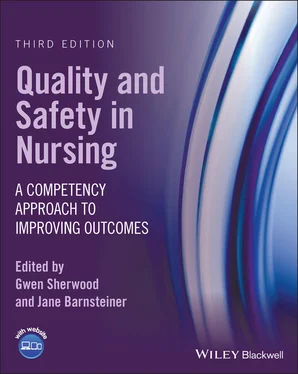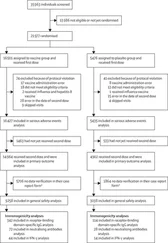Quality and Safety in Nursing
Здесь есть возможность читать онлайн «Quality and Safety in Nursing» — ознакомительный отрывок электронной книги совершенно бесплатно, а после прочтения отрывка купить полную версию. В некоторых случаях можно слушать аудио, скачать через торрент в формате fb2 и присутствует краткое содержание. Жанр: unrecognised, на английском языке. Описание произведения, (предисловие) а так же отзывы посетителей доступны на портале библиотеки ЛибКат.
- Название:Quality and Safety in Nursing
- Автор:
- Жанр:
- Год:неизвестен
- ISBN:нет данных
- Рейтинг книги:5 / 5. Голосов: 1
-
Избранное:Добавить в избранное
- Отзывы:
-
Ваша оценка:
- 100
- 1
- 2
- 3
- 4
- 5
Quality and Safety in Nursing: краткое содержание, описание и аннотация
Предлагаем к чтению аннотацию, описание, краткое содержание или предисловие (зависит от того, что написал сам автор книги «Quality and Safety in Nursing»). Если вы не нашли необходимую информацию о книге — напишите в комментариях, мы постараемся отыскать её.
Quality and Safety in Nursing
Future of Nursing
Quality and Safety in Nursing, Third Edition
Quality and Safety in Nursing — читать онлайн ознакомительный отрывок
Ниже представлен текст книги, разбитый по страницам. Система сохранения места последней прочитанной страницы, позволяет с удобством читать онлайн бесплатно книгу «Quality and Safety in Nursing», без необходимости каждый раз заново искать на чём Вы остановились. Поставьте закладку, и сможете в любой момент перейти на страницу, на которой закончили чтение.
Интервал:
Закладка:
Giving front‐line nurses a place at decision‐making tables, and committing to integrating their recommendations.
While the focus of nurses and other healthcare providers is primarily on the provision of care, what these solutions highlight is the importance of paying equal attention to our systems of care delivery, providing safe working environments for people who are working in highly complex systems, and re‐examining the pre‐ and post‐licensure education of all nurses. These goals align with the December 2020 release of Safer Together: A National Action Plan to Advance Patient Safety , discussed in Chapter 1.
This volume, the third edition of Quality and Safety Education in Nursing , maintains the same laser focus on understanding and developing the six competencies that represent QSEN, but adds content reflecting the current environment. Chapter 1covers driving forces for quality safe care and traces the two decades of progress in the current safety movement, and Chapter 2shares policy perspectives. Chapter 3updates the history and synergy inspired by the QSEN project. Section Two includes updated chapters on each of the six competencies with scenarios, teaching and practice strategies, and related resources. Chapters in Section 3 offer updated content and strategies to guide faculty in interactive classrooms based on unfolding case studies, reflective practice applied to narrative pedagogy, clinical education, leadership, transition to practice, and interprofessionalism.
International exemplars depicting the work and perspectives of global partners threaded throughout the book demonstrate the global imperative of collaborating to shape the way forward to improve quality and safety outcomes. Each chapter teases apart the multiple facets of quality and safety and applies the competencies to everyday components of education, care delivery, and organizational systems. The focus is on new ways to apply the competencies and related knowledge, skills, and attitudes to address contemporary challenges in health care education and practice, to improve the patient care experience, and to contribute to the well‐being of health care professionals. Each contributor is a leader in quality and safety and offers their work to stimulate all nurses and health care professionals to share and disseminate their work around the globe.
Together, we hope to ensure a high‐reliability health care system focused on safety and quality. It is our hope that the expanding story of QSEN provides motivation and will , that the expansive tool kit within these pages stimulates ideas , and that the continuing efforts of all nurses translate into execution as we develop new generations of nurses fully prepared to lead and work in health care systems based on cultures of quality and safety. In this past year, often called “a year like no other,” we have seen how these six competencies have continued to provide an evidence‐based foundation for nursing practice and education. As we move forward into the future, we anticipate that this will continue as we also tackle new challenges in health care and society, eliminating preventable harm in systems that achieve health equity and racial justice for every patient, every time.
Gwen Sherwood, PhD, RN, FAAN, ANEF
Jane Barnsteiner, PhD, RN, FAAN
References
1 Graham, J. (2020) Why Black aging matters, too. KHN, September 3. Retrieved January 13, 2021 from https://khn.org/news/why‐black‐aging‐matters‐too.
2 National Steering Committee for Patient Safety. (2020) Safer Together: A National Action Plan to Advance Patient Safety. Boston, MA: Institute for Healthcare Improvement. Retrieved June 27, 2021 from www.ihi.org/SafetyActionPlan.
3 WikiWisdom Forum. (2020) Frontline Nurses. Retrieved January 13, 2021 from https://static1.squarespace.com/static/5ae939332714e568d4990eb3/t/5f5be0b63afa8a3d70290ae3/1599856832078/WikiWisdom‐Nurses.pdf.
4 World Health Organization. (2020) State of the World’s Nursing. Geneva: WHO. Retrieved June 27, 2021 from https://www.who.int/publications/i/item/9789240003279.
About the Companion Website
This book is accompanied by a companion website:
www.wiley.com/go/qualityandsafetyinnursing3e 
This hosts supplementary content that accompanies this textbook including PPT slides for use in teaching.
1 Driving Forces for Quality and Safety: Changing Mindsets to Improve Health Care
Gwen Sherwood, PhD, RN, FAAN, ANEF
Julia stashed her umbrella and looked at the overflowing waiting room of the Emergency Department (ED) where she had worked weekends for the past five years. It was summer and staffing was short even for a Sunday evening in August; several staff were on vacation and one had called in sick. A storm had pounded the area, and there was a power outage. The hospital was on the emergency generators, and that meant the electronic chart was slow in response because of the overload. Staff were taking shortcuts due to time pressures. Julia thought about these breakdowns and remembered the workshop she had recently attended on quality improvement. The focus had been on identifying problems and applying quality improvement tools to collect data on the problem, analyze results, and design solutions to close the gap between actual and desired practice. She noted that Ms. Masraf was in the waiting area; she had diabetes, and wounds were difficult to heal. Infection was a constant threat so she had been to the ED on several occasions. Julia turned at the sound of a crash and saw that one of the nurse aides had fallen where water had collected from wet umbrellas. Falls were common in the ED as a result of the population served and, with social distancing precautions from the current global pandemic, there were fewer family members to help patients with mobility issues. She wondered if she could initiate a quality improvement study on any of these continuing problems she saw every time she came to work. Other staff seemed to think this was just a part of how the ED functioned and were exhausted from the additional burden of the pandemic .
What evidence‐based instructional strategies can inspire and prepare health professionals to lead redesign of increasingly complex systems?
What are the continuing barriers to reliable reporting systems in transparent just cultures?
How do we prevent making the same mistakes over and over?
What is the impact of the COVID‐19 pandemic on quality and safety issues?
Patient safety and quality are primary concerns in almost every country. It is now recognized that preventable patient harm is a leading cause of death worldwide. The 1999 release of a stark report on the quality of health care in the United States, To Err Is Human (Institute of Medicine [IOM], 2000) ignited a call to action. Following a series of reports referred to as the Quality Chasm, consumers, regulatory agencies, and professional and public organizations have demanded system improvements. In these 20 years since the IOM (now the National Academy of Medicine) released the initial report, countless safety initiatives have sought to prevent harm. Education is the primary intervention for reducing preventable harm by changing providers’ knowledge, skills, and attitudes about quality and safety that guide how they deliver care.
Quality and safety are intertwined, complex concepts with multiple dimensions. Lack of a comprehensive understanding of the full scope of these terms to overcome historical views poses a barrier for implementing quality and safety strategies. It is difficult to reshape mental models held by health care workers to develop new mindsets and attitudes about the imperative of quality and safety. Patient safety comprises the collective actions that create cultures, processes, technologies, and environments that mitigate risk of preventable harm (World Health Organization [WHO], 2021; see Chapter 8). The goal of quality improvement is to implement best practices to achieve best outcomes, accomplished first by measuring the reality of care delivered compared with benchmarks or the ideal outcome (Allen‐Duck et al ., 2017; see Chapter 6). Continuous quality monitoring is the mechanism for transforming the health care system, but it requires the collaboration of health care professionals, patients and their families, researchers, payers, planners, and educators working toward better patient outcomes (health) and better system performance (care).
Читать дальшеИнтервал:
Закладка:
Похожие книги на «Quality and Safety in Nursing»
Представляем Вашему вниманию похожие книги на «Quality and Safety in Nursing» списком для выбора. Мы отобрали схожую по названию и смыслу литературу в надежде предоставить читателям больше вариантов отыскать новые, интересные, ещё непрочитанные произведения.
Обсуждение, отзывы о книге «Quality and Safety in Nursing» и просто собственные мнения читателей. Оставьте ваши комментарии, напишите, что Вы думаете о произведении, его смысле или главных героях. Укажите что конкретно понравилось, а что нет, и почему Вы так считаете.












